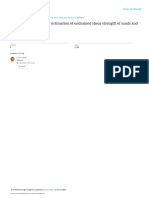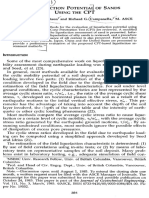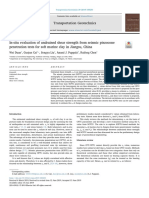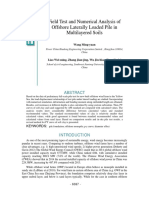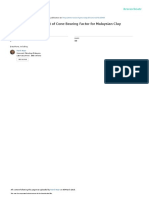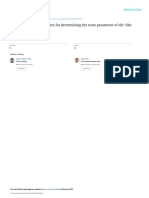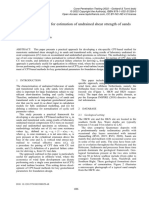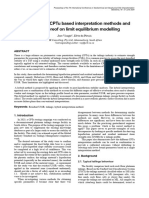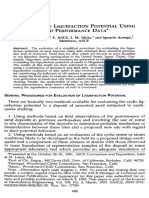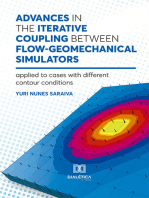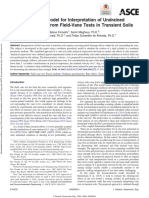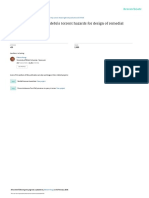Mayne Peuchen 2022 Undrainedshearstrengthofclaysfrompiezoconetestdatabase
Mayne Peuchen 2022 Undrainedshearstrengthofclaysfrompiezoconetestdatabase
Uploaded by
Ten FreireCopyright:
Available Formats
Mayne Peuchen 2022 Undrainedshearstrengthofclaysfrompiezoconetestdatabase
Mayne Peuchen 2022 Undrainedshearstrengthofclaysfrompiezoconetestdatabase
Uploaded by
Ten FreireOriginal Title
Copyright
Available Formats
Share this document
Did you find this document useful?
Is this content inappropriate?
Copyright:
Available Formats
Mayne Peuchen 2022 Undrainedshearstrengthofclaysfrompiezoconetestdatabase
Mayne Peuchen 2022 Undrainedshearstrengthofclaysfrompiezoconetestdatabase
Uploaded by
Ten FreireCopyright:
Available Formats
See discussions, stats, and author profiles for this publication at: https://www.researchgate.
net/publication/361157395
Undrained shear strength of clays from piezocone tests: A
database approach
Chapter · June 2022
DOI: 10.1201/9781003308829-78
CITATIONS READS
0 151
2 authors, including:
Paul W. Mayne
Georgia Institute of Technology
275 PUBLICATIONS 8,106 CITATIONS
SEE PROFILE
All content following this page was uploaded by Paul W. Mayne on 28 November 2022.
The user has requested enhancement of the downloaded file.
Undrained shear strength of clays from piezocone tests: a database
approach
P.W. Mayne
Georgia Institute of Technology, Atlanta, GA USA
J. Peuchen
Fugro, Nootdorp, The Netherlands
Mayne, P.W. and Peuchen, J. (2022). Undrained shear strength of clays from piezocone tests: a database approach.
Proceedings, 5th Intl. Symposium on Cone Penetration Testing (CPT'22, Bologna), Paper ID 1107: 546-551.
ABSTRACT: Deriving undrained shear strength of clays from piezocone tests (CPTU) suits the use of a data-
base approach, particularly because good correlations are expected on the basis of theoretical correspondence.
Benefits of a database approach include a minimal environmental footprint and field schedule shortening, pri-
marily because of reduced borehole sampling and laboratory testing focused on verification rather than devel-
opment of comprehensive site-specific data sets. This paper expands on the classic expression su = qnet/Nkt
where su is a reference undrained shear strength obtained by laboratory testing, qnet is the net cone resistance
and Nkt is a cone bearing factor that is noted to decrease with increasing values of CPTU pore pressure ratio Bq.
The database includes CPTU results and high-quality laboratory triaxial compression tests from 70 different
clay deposits, of which 8 represent new case studies. The clays are allocated to 5 main categories: (a) soft-firm
offshore; (b) soft-firm onshore; (c) soft sensitive; (d) stiff overconsolidated intact; and (e) stiff fissured clays.
Organic clays and cemented clays are excluded.
1 INTRODUCTION Here, an empirical database approach is consid-
ered for Nkt. The database approach uses data from
When a geotechnical exploration discovers that clay high quality piezocone penetration test (CPTU) re-
forms all or a portion of the subsurface environment, sults matched at the same elevations as high quality
the magnitude of the undrained shear strength (su) pa- samples subjected to laboratory testing.
rameter is generally sought for input into calculation
models involving ground stability, particularly re- 2 DATABASE PARAMETERS
lated to shallow foundations, pilings, and slopes. Un-
drained shear strength can also be important for tran- 2.1 Triaxial compression tests
sitional soils and sands, where combinations of
geometry and loading rate can lead to undrained soil The reference undrained shear strength was defined
response. as a triaxial compression mode, designated suc:
Undrained shear strength is not a unique property of ● Derived value (Eurocode 7) of suc from laboratory
clays but affected by many variables, including mode tests on Class 1 samples (ISO 22475-1:2006);
of shearing, rate of loading, shear direction, initial ● Anisotropically-consolidated undrained triaxial
stress state, failure criterion and other factors (Mayne compression tests (CAUC or CK0UC) according to
2008). This paper expands on the most common ex- ISO 17892-9:2018 or equivalent; Note for fissured
pression su = qnet/Nkt where su is a reference undrained clays, often only CIUC tests were available;
shear strength, qnet is net cone resistance and Nkt is a ● Recompression to the estimated in-situ stress con-
cone bearing factor according to classical bearing ca- ditions, using conventional back pressures for
pacity theory. Values of Nkt can be obtained from an- specimen re-saturation;
alytical, theoretical, or numerical solutions, such as ● suc = ½(σ1-σ3)max defined as failure criterion or
those based on limit plasticity, cavity expansion, fi- (1'/3')max as failure criterion when (σ1-σ3) pro-
nite elements, and strain path method. Well over 50 vides no distinct maximum (Ladd & DeGroot
solutions are available for Nkt (e.g., Lunne, et al. 2003; Lade 2016), where σ1' and σ3' are the effec-
1997; Yu & Mitchell 1998; Colreavy 2016; Agaiby tive principal stresses.
2018).
2.2 Piezocone penetration tests ure 1 and Equation 1 (Mayne & Peuchen 2018), for
For the CPTU (ISO 22476-1:2012), three separate when Bq > -0.1:
measurements are obtained: (a) corrected cone re-
sistance, qt; (b) sleeve friction, fs; and (c) pore pres- Nkt = 10.5 - 4.6 ∙ lne (Bq + 0.1) (1)
sure, u2. These measurements are acquired at depth
intervals of between 10 mm and 50 mm during a con- Comments are as follows:
stant vertical push rate of 20 mm/s.
For each elevation, values of qnet and pore pressure ● An advantage of this approach over many other so-
ratio Bq were derived: lutions for Nkt is that the CPTU provides all the
necessary input;
● qnet = qt - vo, where vo = total vertical overburden ● The methodology covers a wide range of clays
stress; showing Bq > -0.1, including soft to firm to stiff
● Bq = u2/qnet, where u2 = u2 - u0 and u0 = hydro- clays which vary from sensitive to insensitive, and
static pressure. intact to fissured;
● The approach does not apply to organic or ce-
Of further note, fs can be used to provide an evalu- mented clays.
ation of the soil unit weight () needed in the calcula-
tion of vo (Mayne et al. 2010a, 2010b; Mayne & Since the initial database findings, a number of new
Peuchen 2012). Consequently, all three readings (qt, case studies have become available that permit a val-
fs, u2) are utilized in the assessment of suc of clays. idation of Equation 1. Herein, triaxial and CPTU data
from 8 clays from Europe, Asia, and North America
are presented. Three sites are from offshore locations
3 TRIAXIAL - PIEZOCONE DATABASE and five clays are onshore deposits.
A total of 62 natural clays that were subjected to
CAUC lab testing (n = 407) provided the initial basis 4 NEW CASE STUDIES
for this study (Mayne 2014). The majority of clays
were deposited in a marine environment, although a 4.1 Luva, Norwegian Sea
few were lacustrine or alluvial or deltaic in origin. A Luva is an offshore gas reserve located in 1300 water
few sensitive clays were originally formed as sedi- depth of the Norwegian sea. The site consists of very
ments in salt-water and later exposed to leaching by soft plastic clays having sensitivities in the range of 2
freshwater. to 5. Index testing indicates a natural water content
The clay sites were classified into 5 separate groups wn ≈ 65 % to 75 %, liquid limit wL ≈ 70 %, plastic
(Mayne & Peuchen 2018), including: (a) 17 offshore limit wP ≈ 29 %, and plasticity index Ip ≈ 41 % (Lunne
clays that were normally-consolidated (NC) to et al. 2014). Series of consolidation tests indicate that
lightly-overconsolidated (LOC); (b) 29 onshore clays the site has not been mechanically overconsolidated,
that were also NC - LOC, (c) 6 soft sensitive clays; showing yield stress ratios (YSR = p'/vo') in the
(d) 5 intact overconsolidated clays (OC); and (e) 5 fis- general range of 1.2 to 1.7, primarily due to ageing.
sured OC clays. Figure 2 shows qt and u2 with depth below the sea-
From the database approach, the general trend of floor, pore pressure ratio Bq, and derived profile of suc
the relationship for evaluating Nkt is presented in Fig from the Nkt relationship. In the last graph, the CPTU
results are shown in comparison with 42 CAUC tri-
axial tests with good agreement.
4.2 Sipoo, Finland
Sipoo is located about 30 km north of Helsinki. The
site consists of a homogeneous soft clay deposit be-
tween 2 and 9 m depth and water table near the sur-
face (DiBuò et al. 2019). Index tests on the clay in-
clude: wn = 101 ± 12 %, wL = 79 ± 10 %, wP = 30 ±
1 %, Ip = 50 ± 9 %, and clay fraction CF = 79 ± 11 %.
Laboratory CRS consolidation tests give a mean YSR
= 1.76 and sensitivity by laboratory fall cone ranges
from 15 to 44 with a mean St = 25 ± 8.
Results from a representative CPTU at Sipoo are
shown in Figure 3. The CPTU-evaluated profiles of
suc compare well with the four laboratory CAUC test
Figure 1. Trend of Nkt with Bq (Mayne & Peuchen 2018) values on high-quality samples taken from the site.
1.83. Mean values of laboratory index parameters in-
clude: wn = 107 ± 20 %, wL = 88 ± 20 %, wP = 38 ±
4 %, and Ip = 54 ± 13 %.
Using the aforementioned consolidation data and
normalized undrained strength ratios from triaxial
compression tests on Saga clay reported by Samang
and Miura (2005), a profile of undrained shear
strength was developed using the SHANSEP method
(Ladd & DeGroot 2003). Figure 4 shows the compar-
ison of the laboratory reference profile of suc in very
good agreement with the CPTU derived values.
4.4 Tiller-Flotten, Norway
Figure 2. Profiles in clay at offshore Luva site, Norwegian Sea
(data from Lunne et al. 2014) Tiller-Flotten near Trondheim, Norway serves as the
experimental grounds involving quick clay research
(L'Heureux et al. 2019). Groundwater is subjected to
drawdown so that the hydrostatic pressure is consid-
erably lower than normal.
Figure 5 shows a representative piezocone sound-
ing (Mayne et al. 2019). The uppermost 2.5 m of soil
is interpreted as a dry/desiccated layer of stiff over-
consolidated sandy clay. Beneath this crust, through-
out the sounding depths up to 30 m lies a soft fine-
grained soil. The clay is extremely sensitive to quick
from approximately 7.5 m below the surface (sensi-
tivity > 100). In the quick clay zone below 7 m depth,
typical index parameters are wn = 45 %, wL = 35 %,
Figure 3. Profiles at Sipoo soft clay test site, Finland (data from
DiBuò et al. 2019) wP = 20 %, and Ip = 15 %, with CF ≈ 45 %.
Figure 5 shows very good agreement from the
CPTU-derived suc values with those obtained from 7
benchmark CAUC series on high-quality block sam-
ples.
Figure 4. Profiles in soft clay at Saga, Japan (data from Hossain
& Chai 2014) Figure 5. Profiles in highly sensitive clay at Tiller-Flotten re-
search site, Norway (data from L'Heureux et al. 2019)
4.3 Saga, Japan
The Saga TB site is located at the south of Japan next
to the Ariake Sea. The upper 4 to 5 m is comprised of 4.5 Sainte-Monique, Canada
sandy silty clay while the underlying 12 m is a silty Locat et al. (2015) detail the results of ground inves-
clay. Groundwater is encountered at a depth of 0.6 m. tigations for a major landslide involving firm to stiff
Figure 4 shows profiles from a representative sensitive nearly normally-consolidated plastic grey
CPTU at the site (Hossain & Chai 2014). Nine con- silty clay. The site is located some 130 km northeast
solidation tests on this clay indicated a mean YSR = of Montreal near the Nicolette River. Index tests show
56 ≤ wn ≤ 77%, 53 ≤ wL ≤ 65 % , 28 ≤ IP ≤ 40%, 72
< CF < 85%, and liquidity index 1.1 ≤ LI ≤ 1.4. Sen- 4.7 Martin's Point Bridge, United States
sitivities derived from fall cone indicate 39 ≤ St ≤ 55. A field case study with CPTU soundings in natural
Laboratory consolidation tests gave YSR between 0.9 overconsolidated intact clays of the Presumpscot For-
and 1.2. mation is presented using data from Martin's Point
Figure 6 shows the piezocone profile in an undis- Bridge, near Portland, Maine (Hardison & Landon
turbed area outside of the limits of the landslide. The 2015). The general stratification of the site (Figure 8)
high value of Bq gives a low value of Nkt which in turn consists of a shallow organic silt layer underlain by
compares well with two CAUC and three CIUC tri- stiff OC Presumpscot clay that extends from depths
axial tests performed on undisturbed samples. to 2 to 14 m and overlies glacial outwash sand and
bedrock.
Shelby tube samples of the clay were collected at
the site from different elevations and tested for index
properties, consolidation parameters, and triaxial
strength characteristics. The results of laboratory in-
dex testing on the clay gave an average unit weight
= 16.5 kN/m3, natural water contents wn ≈ 30 to 40 %,
liquid limits in the range of 20 ≤ wL ≤ 45 %, and plas-
ticity indices (Ip) between 10 and 20 %. Sensitivities
derived from field vane and fall cone were generally
in the range of 2 to 9.
The groundwater table is located at a depth of 2 m.
Figure 6. Profiles in sensitive clay at Sainte Monique, Quebec The stress history profile was determined by a series
(data from Locat et al. 2015) of 13 constant-rate-of-strain (CRS) consolidation
tests that showed YSRs decreasing from 11 at 2 m
depth to YSR = 3 at 14 m depth.
A total of 15 CAUC triaxial tests were performed,
including both recompression and SHANSEP type
methods (Ladd & DeGroot 2003). The derived profile
of suc from the CPTU is presented in Figure 8 with
values increasing from about 35 to 100 kPa in the de-
posit and shown to be in reasonably good agreement
with the triaxial series.
Figure 7. Profiles in soft plastic clay at Liwan offshore site,
South China Sea (data from Palix et al. 2013)
4.6 Liwan, South China Sea
A deepwater geotechnical investigation was per-
formed at the Liwan 3-1 offshore site in the Pearl
River Mouth Basin of the South China Sea involving
geophysics, sampling, piezocones, T-bars, vane, dis-
sipation tests, and advanced laboratory testing (Palix
et al. 2013). The site is underlain by soft highly-plas- Figure 8. Profiles in firm OC clay at Martin's Point Bridge,
tic clays. Liquid limits decrease from 130 % at sea- Maine (data from Hardison & Landon 2015)
floor to 80 % at 10 m below seafloor, with corre-
sponding Ip going from 85 % to 50 % over the same 4.8 Offshore Denmark
depth interval. Clay fractions range between 25 to
50 %. Natural water contents vary from over 200 % This case study considers the Danish sector of the
at seafloor to about 90 % at 20 m depth. Measure- North Sea. The site has a water depth of about 45 m
ments of calcium carbonate content range from 6 % and includes about 3 m of Holocene sands which are
to 25 %. underlain by hard Pleistocene age clays of the Dog-
Figure 7 shows a piezocone profile and the corre- gerbank formation. Laboratory index tests on the clay
sponding and reasonable profiles of suc from the rep- indicate mean values: wn = 34 %, wL = 49 %, Ip =
resentative CPTU sounding and 6 CAUC triaxial 27 % and γ = 19.4 kN/m3. Calcium carbonate contents
tests.
average 19 % for the clay. Consolidation tests indi- DeGroot, D., Lunne, T. and Tjelta, T.I. (2011). Recommended
cate the clay to be overconsolidated with YSR de- best practice for geotechnical site characterization of cohe-
sive offshore sediments. Frontiers in Offshore Geotechnics
creasing from about 9 to 4 in the depth interval from II (Proc. ISFOG, Perth), Taylor & Francis Group, London:
3 to 15 m below the seafloor. 33-57.
Figure 9 shows low Bq values averaging 0.08, the DiBuö, B., D'Ignazio, M., Selãnpaã, J., Länsivaara, T. and
Nkt-Bq algorithm gave a high mean value of Nkt = 21 Mayne, P.W. (2019). Yield stress evaluation of Finnish clays
for the clay and the corresponding profile of suc com- based on analytical CPTu models. Canadian Geotech. Jour.
pares reasonably with the values from only two 57 (11): 1623 - 1638; doi.org/10.1139/cgj-2019-0427.
Hardison, M.A. and Landon, M.L. (2015). Correlation of engi-
CAUC tests on undisturbed samples from the site. neering parameters of the Presumpscot formation to SCPTU.
Report No. ME 15-12, prepared by Univ. of Maine for Maine
DOT, Augusta, 394 p.
Hossain, J. and Chai, J. (2014). Estimating coef. of consolidation
and hydraulic conductivity from piezocone test results. Geo-
mechanics and Engineering 6 (6): 577-592.
Hong, S.J., Lee, M.J., Kim, J.J. and Lee, W.J. (2010). Evaluation
of undrained shear strength of Busan clay using CPT. Proc.
2nd Intl. Symp. on Cone Penetration Testing, Vol. 2 (Hun-
tington Beach, CA), Omnipress: 313-320.
ISO (International Organization for Standardization) 2012. Ge-
otechnical investigation and testing – Field testing – Part 1:
Electrical cone and piezocone penetration tests, International
Standard ISO 22476-1:2012. (with technical corrigendum 1,
January 2013). Geneva.
Karlsrud, K., Lunne, T. and Brattlien, K. (1996). Improved
Figure 9. Profiles in stiff fissured OC Doggerbank clay at Dan- CPTU interpretations based on block samples. Proc. Nordic
ish offshore site. Geotechnical Meeting, Reykajavik, Paper 3.4: 195-201.
Knappett, J.A. and Craig, R.F. (2012). Craig's Soil Mechanics,
8th Edition, Spon Press, Taylor & Francis Group, London:
570 pages.
5 CONCLUSIONS L'Heureux, J-S., Lindgård, A. and Emdal, A. (2019). The Tiller-
Flotten research site: geotechnical characterization of a very
The empirical methodology considers cone bearing sensitive clay deposit. AIMS Geosciences Volume 5, Issue 4:
factor (Nkt = qnet/suc) as a function of pore pressure 831-867
ratio (Bq = u2/qnet). The underlying database in- Ladd, C.C. and DeGroot, D.J. (2003). Recommended practice
cludes statistical analyses of 407 CAUC triaxial tests for soft ground site characterization. Soil & Rock America
2003, Vol. 1 (Proc. 12 PCSMGE, MIT), Vertag Glückauf,
performed on 62 different clay deposits that were also Essen: 3-57.
field tested by CPTU. Lade, P.V. (2016). Triaxial Testing of Soils, John Wiley & Sons,
The general trend shows Nkt varying from as high Ltd, Chichester, UK: 402 p.
as 30+ for stiff fissured overconsolidated clays to low Locat, A., Leroueil, S., Fortin, A., Demers, D. and Jostad, H.P.
values of around 6 for soft sensitive and quick clay (2015). The 1994 landslide at Sainte-Monique, Quebec: ge-
otechnical investigation. Canadian Geotechnical Journal 52
deposits. Generally, Nkt decreases with Bq. (4): 490-504.
Eight new case studies are presented showing the Low, H.E., Lunne, T., Andersen, K.H., Sjursen, M.A., and Ran-
reasonableness and reliability of the earlier-derived dolph, M.F. (2010). Estimation of intact and remoulded un-
methodology for assessing undrained strength of drained shear strengths from penetration tests in soft clays.
clays from piezocone penetration tests. Triaxial com- Geotechnique 60 (11): 843-859.
pression tests (CAUC, CK0UC, and occasionally Lunne, T., Christoffersen, H.P. and Tjelta, T.I. (1985). Engi-
neering use of piezocone data in North Sea clays. Proc.
CIUC) on high-quality undisturbed samples were ICSMFE, Vol. 2, San Francisco, 907-912.
used as the benchmark reference tests. The final tally Lunne, T., Robertson, P.K. and Powell, J.J.M. (1997). Cone
for the database now includes CPTU data from 70 Penetration Testing in Geotechnical Practice, Routledge -
clay sites and a total of 497 triaxial compression tests Taylor & Francis Group, London: 352 p.
that provide the benchmark values of suc. Lunne, T. (2010). The CPT in offshore soil investigations - a
historic perspective. Geomechanics & Geoengineering, Vol.
7 (2): 75-101.
6 REFERENCES Lunne, T., Andersen, K.H. and Yang, S.L. (2014). Undrained
shear strength for deep water field development in the Nor-
wegian Sea. Proceedings. 5th International Workshop on
Agaiby, S.S. (2018). Advancements in the interpretation of seis-
mic piezocone tests in clays and other geomaterials. PhD dis- CPTU and DMT in soft clays and organic soils, Polish Com-
sertation, Civil & Environmental Engineering, Georgia In- mittee of Geotechnics, Poznan: 213-228.
Mayne, P.W. (2008). Piezocone profiling of clays for maritime
stitute of Technology, Atlanta, GA: 923 p.
Colreavy, C. (2016). Use of piezoball penetrometers for meas- site investigations. Geotechnics in Maritime Engineering,
uring shear strength and consolidation characteristics of soft Vol. 1 (Proc. 11th Baltic Sea Geotechnical Conference,
Gdansk), Polish Committee on Geotechnics: 333-350.
soil. PhD dissertation, Centre for Offshore Foundation Sys-
tems, Univ. of Western Australia, Perth: 304 pages.
Mayne, P.W, Peuchen, J., and Bouwmeester, D. (2010a). Unit
weight evaluation from CPT. Proceedings, 2nd Intl. Sympo-
sium on Cone Penetration Testing (CPT'10), Vol. 2, Hun-
tington Beach, California: 169-176.
Mayne, P.W, Peuchen, J., and Bouwmeester, D. (2010b). Soil
unit weight estimated from CPTu in offshore soils. Frontiers
in Offshore Geotechnics II (Proc. ISFOG, Perth), Taylor &
Francis Group, London: 371-376.
Mayne, P.W. and Peuchen, J. (2012). Unit weight trends with
cone resistance in soft to firm clays. Geotechnical and Geo-
physical Site Characterization 4, Vol. 1 (Proc. ISC-4, Per-
nambuco), CRC Press, London: 903-910.
Mayne, P.W. (2014). Development of an automated methodol-
ogy for evaluation of undrained shear strength of offshore
clays from piezocone penetration tests. Report 122931 by
Georgia Tech Research Corp. (Project No. 2006U94) to
Fugro, The Netherlands: 192 p.
Mayne, P.W., Peuchen, J. & Baltoukas, D. (2015). Piezocone
evaluation of undrained strength in soft to firm offshore
clays. Frontiers in Offshore Geotechnnics III, Vol. 2
(ISFOG, Oslo), Taylor & Francis, London: 1091-1096.
Mayne, P.W. & Peuchen, J. (2018). Evaluation of CPTU Nkt
cone factor for undrained strength of clays. Cone Penetration
Testing 2018 (Delft), CRC: 423-429.
Mayne, P.W., Paniagua, P., L'Heureux, J-S., Lindgård, A., and
Emdal, A. (2019). Analytical CPTu model for sensitive clay
at Tiller-Flotten, Norway. Proc. XVII ECSMGE: Paper 0153,
Reykjavik, Icelandic Geotechnical Society:
www.issmge.org.
Palix, E., Chan, N., Yangrui, Z. and Haijin, W. (2013). Liwan 3-
1: How deep water sediments from South China Sea compare
with Gulf of Guinea sediments. Proceedings, Offshore Tech-
nology Conference, Houston, Texas, OTC Paper 24010, Vol
2, 1101-1108.
Paniagua, P., L'Heureux, J-S., Carroll, R., Kåsin, K. and Sjursen,
M. (2017). Evaluation of sample disturbance of three Nor-
wegian clays. Proc. Intl. Conf. on Soil Mechanics and Ge-
otechnical Engineering, Seoul, 481-484. www.issmge.org
Powell, J.J.M. & Quarterman, R.S.T. (1988). The interpretation
of cone penetration tests in clays with particular reference to
rate effects. Penetration Testing 1988, Vol. 2 (Proc. ISOPT-
1, Orlando), Balkema, Rotterdam: 903-909.
Robertson, P.K. 2009. Interpretation of cone penetration tests: a
unified approach. Canadian Geotechnical Journal 46 (11):
1337-1355.
Samang, L., Miura, N. and Sakai, A. (2005). Geotechnical prop-
erties of soft cohesive lowland soils deposited in Saga Air-
port Highway, Japan. Media Komunikasi Teknik Sipil, Vol.
13 (3): EDISI XXXIII: 19-35
Schnaid, F. (2009). In Situ Testing in Geomechanics: The Main
Tests. CRC Press, Taylor & Francis Group, London, 352
pages.
Yu, H.S. and Mitchell, J.K. (1998). Analysis of cone resistance:
review of methods. Journal of Geotechnical and Geoenvi-
ronmental Engineering 124 (2): 140-149.
View publication stats
You might also like
- Mayne & Peuchen 2018 - Evaluation of CPTu NKTDocument7 pagesMayne & Peuchen 2018 - Evaluation of CPTu NKTCarlos SantosNo ratings yet
- Field Evaluation of Undrained Shear Strength From Piezocone Penetration Tests in Soft Marine ClayDocument12 pagesField Evaluation of Undrained Shear Strength From Piezocone Penetration Tests in Soft Marine ClayDr.Ch.Rama Vara Prasad Assistant Professor, CE, VRSECNo ratings yet
- Lacasse (1988) Design Parameters of Clays From in Situ and Laboratory TestsDocument47 pagesLacasse (1988) Design Parameters of Clays From in Situ and Laboratory TestsbryanerickjorgebNo ratings yet
- From Burst Test To Bi-Axial Tensile TestDocument15 pagesFrom Burst Test To Bi-Axial Tensile TestJustin MillerNo ratings yet
- Problem Set On DynamicsDocument40 pagesProblem Set On DynamicsMa. Socorro Angela LlavoresNo ratings yet
- Mayne Peuchen 2022 Undrained Shear Strength of Clays From Piezocone Test DatabaseDocument7 pagesMayne Peuchen 2022 Undrained Shear Strength of Clays From Piezocone Test DatabaseGean Lopes TeixeiraNo ratings yet
- CGJ 2017 0451Document56 pagesCGJ 2017 0451arslanpasaNo ratings yet
- Ouyang & Mayne 2018 - Mini-CPTu in Centrifuge Clayey SoilsDocument6 pagesOuyang & Mayne 2018 - Mini-CPTu in Centrifuge Clayey Soilschin_kbNo ratings yet
- Estimation of Tunis Soft Soil UndrainedDocument6 pagesEstimation of Tunis Soft Soil UndrainedLuis Orlando Ibanez MoraNo ratings yet
- Schneider EtalDocument31 pagesSchneider EtalAbhishek Ghosh DastiderNo ratings yet
- CPTU Correlations For ClaysDocument11 pagesCPTU Correlations For ClaysPRITAM KUNDU 1301024No ratings yet
- CPTU Correlations For ClaysDocument11 pagesCPTU Correlations For ClaysPRITAM KUNDU 1301024No ratings yet
- Calculation of Undrained Shear Strength of A Bauxite Tailings Using Field and Laboratory TestsDocument12 pagesCalculation of Undrained Shear Strength of A Bauxite Tailings Using Field and Laboratory TestsAndréNo ratings yet
- Icsmge 2022-65Document7 pagesIcsmge 2022-65fraztyaNo ratings yet
- Effects of Plasticity and Sample Disturbance On Statistical Properties of UndrainedDocument11 pagesEffects of Plasticity and Sample Disturbance On Statistical Properties of UndrainedthalesgmaiaNo ratings yet
- A Technique For Estimating The Shaft Resistance of Test Piles in Unsaturated SoilsDocument7 pagesA Technique For Estimating The Shaft Resistance of Test Piles in Unsaturated SoilsjohndimNo ratings yet
- 2022, K. Kaltekis & J. Peuchen - A CPT-based Method For Estimation of Undrained Shear Strength of Sands andDocument6 pages2022, K. Kaltekis & J. Peuchen - A CPT-based Method For Estimation of Undrained Shear Strength of Sands andHILARY DUFFNo ratings yet
- (1985 Robertson and Campanella) Liquefaction Potencial of Sands Using CPTDocument20 pages(1985 Robertson and Campanella) Liquefaction Potencial of Sands Using CPTsanpaz75100% (1)
- Strength Characterisation of Soil-Based Construction Materials - BeckettDocument38 pagesStrength Characterisation of Soil-Based Construction Materials - BeckettVicente CapaNo ratings yet
- 2017GeoOttawa Cu SPTDocument9 pages2017GeoOttawa Cu SPTAndresGarciaNo ratings yet
- (Bonin and Shaigetz et al. ,2022) In-situ and laboratory site specific geotechnical characterization of hard rock gold mine tailingsDocument13 pages(Bonin and Shaigetz et al. ,2022) In-situ and laboratory site specific geotechnical characterization of hard rock gold mine tailingsMayara FerreiraNo ratings yet
- Boschi Et Al. 2023 - Effects of Drainage Conditions On State Parameter Inversion From CPTuDocument7 pagesBoschi Et Al. 2023 - Effects of Drainage Conditions On State Parameter Inversion From CPTuBOOBOONo ratings yet
- Comparison Between Soil Properties Derived From CPT Tests and LaboratoryDocument6 pagesComparison Between Soil Properties Derived From CPT Tests and Laboratoryg5680No ratings yet
- Transportation Geotechnics: SciencedirectDocument10 pagesTransportation Geotechnics: SciencedirectDr.Ch.Rama Vara Prasad Assistant Professor, CE, VRSECNo ratings yet
- 0877 Ecsmge 2019 - NepelskiDocument7 pages0877 Ecsmge 2019 - Nepelskiqwerty2500No ratings yet
- Stress History and Effective Shear Strength Parameters Evaluation of A Dilative Stiff ClayDocument8 pagesStress History and Effective Shear Strength Parameters Evaluation of A Dilative Stiff ClayAndréNo ratings yet
- Norsk Clays VSQT FinalDocument30 pagesNorsk Clays VSQT FinalRoger RodriguesNo ratings yet
- Influence of Test Equipment and Procedures On Obtained Accuracy in CPTUDocument26 pagesInfluence of Test Equipment and Procedures On Obtained Accuracy in CPTUAlex Jose Bracamonte MirandaNo ratings yet
- CPTU Powell Lunne Art03 - No34 - 2005Document38 pagesCPTU Powell Lunne Art03 - No34 - 2005chrislop92No ratings yet
- Field Test and Numerical Analysis of Offshore Laterally Loaded Pile in Multilayered SoilsDocument16 pagesField Test and Numerical Analysis of Offshore Laterally Loaded Pile in Multilayered SoilsDoThanhTungNo ratings yet
- Computers and Geotechnics: A. Tolooiyan, K. GavinDocument9 pagesComputers and Geotechnics: A. Tolooiyan, K. Gavinsam kowalskiNo ratings yet
- Kosiakov EgorDocument15 pagesKosiakov EgorSyafiqah Nur FatinNo ratings yet
- Using Percolation Theory To Predict Oil !eldperformanceDocument6 pagesUsing Percolation Theory To Predict Oil !eldperformanceXuan BinhNo ratings yet
- Understanding Tropical Ground Investigation: Cptu in Consolidating SoilsDocument64 pagesUnderstanding Tropical Ground Investigation: Cptu in Consolidating SoilsMohd Khairil Azwar RamliNo ratings yet
- Simplified Model For Evaluating Soil Liquefaction Potential Using CPTUDocument8 pagesSimplified Model For Evaluating Soil Liquefaction Potential Using CPTUIbrahim SuryaNo ratings yet
- Comparison of CPTU and Laboratory Tests Interpretation For Polish and Norwegian ClaysDocument8 pagesComparison of CPTU and Laboratory Tests Interpretation For Polish and Norwegian ClaysNabucodonosor1980No ratings yet
- 134 SottileDocument8 pages134 SottileOscar EduardoNo ratings yet
- Determination of Elastic Modulus From Stress Controlled Cone Penetration TestDocument5 pagesDetermination of Elastic Modulus From Stress Controlled Cone Penetration TestDiego Enrique Durán CaballeroNo ratings yet
- Vaskou, P. (2019) - ISRM Suggested Method For The Lugeon Test.Document20 pagesVaskou, P. (2019) - ISRM Suggested Method For The Lugeon Test.ronle01100% (3)
- Numge2023 10Document7 pagesNumge2023 10WanNo ratings yet
- CPT22 Kaltekis Peuchen Su Sands Transitional SoilsDocument5 pagesCPT22 Kaltekis Peuchen Su Sands Transitional SoilskostaskaltekisNo ratings yet
- 02niachaDocument8 pages02niachahevenancio3No ratings yet
- 5.1 Cone Penetrometer Test - GeneralDocument43 pages5.1 Cone Penetrometer Test - GeneralJAVIER ADRIANNo ratings yet
- Draft_Sanchez_Pinedo_312362831151Document8 pagesDraft_Sanchez_Pinedo_312362831151samrkendallNo ratings yet
- Undrained Shear Strength Cu For Undrained Elastic ModulusDocument10 pagesUndrained Shear Strength Cu For Undrained Elastic ModulusTORA TubeNo ratings yet
- Evaluation of Undrained Shear Strength of Clay Li2018Document6 pagesEvaluation of Undrained Shear Strength of Clay Li2018Juan P MSNo ratings yet
- 2017GeoOttawa Cu-SPTDocument9 pages2017GeoOttawa Cu-SPTAndrew WinnerNo ratings yet
- Interpretation CPTDocument5 pagesInterpretation CPTNadeem AbbasiNo ratings yet
- Mayne 2006 OverView InSitu Singapore ColourDocument57 pagesMayne 2006 OverView InSitu Singapore ColoursenhuNo ratings yet
- 2017GeoOttawa Cu-SPTDocument9 pages2017GeoOttawa Cu-SPTJAIME ANDRES RODRIGUEZNo ratings yet
- T36 - TMW 2021 - Characterization and Evaluation of The Undrained Shear StrengthDocument10 pagesT36 - TMW 2021 - Characterization and Evaluation of The Undrained Shear StrengthMauro P Dos Santos JuniorNo ratings yet
- Interpretation of Centrifuge CPT Data in Normally Consolidated Silica and Carbonate SandsDocument10 pagesInterpretation of Centrifuge CPT Data in Normally Consolidated Silica and Carbonate SandsNatasa KaticNo ratings yet
- Semi-Empirical Method of Interpretation of CPT DataDocument13 pagesSemi-Empirical Method of Interpretation of CPT DataAnonymous AhBB963tNfNo ratings yet
- Bearing Capacity of Driven Piles in Sand, The NGI Approach: August 2005Document6 pagesBearing Capacity of Driven Piles in Sand, The NGI Approach: August 2005parvejNo ratings yet
- Art 3Document11 pagesArt 3nawel dounaneNo ratings yet
- Paper - 36 Paniagua LHeureux Yang Lunne ngm2016Document10 pagesPaper - 36 Paniagua LHeureux Yang Lunne ngm2016vkkr4567No ratings yet
- 2006 JAPP GarchyDocument15 pages2006 JAPP GarchyBagus Bayu PrabowoNo ratings yet
- 6 - Effect of Reconstitution Techniques On The Triaxial Stress-Strength Behaviour of A Very Dense Sand - 2019Document9 pages6 - Effect of Reconstitution Techniques On The Triaxial Stress-Strength Behaviour of A Very Dense Sand - 2019JuanNo ratings yet
- (1983 Seed and Idriss) Evaluation of Liquefaction Potential Using Field Performance DataDocument25 pages(1983 Seed and Idriss) Evaluation of Liquefaction Potential Using Field Performance Datasanpaz75No ratings yet
- Paredes & Illingworth 2022 - Evaluation of Shear Wave Velocity Profiles in Alluvial and Deltaic Soils Using a CPT DatabaseDocument5 pagesParedes & Illingworth 2022 - Evaluation of Shear Wave Velocity Profiles in Alluvial and Deltaic Soils Using a CPT DatabaseJip Nooy van der KolffNo ratings yet
- Advances in the iterative coupling between flow-geomechanical simulators: applied to cases with different contour conditionsFrom EverandAdvances in the iterative coupling between flow-geomechanical simulators: applied to cases with different contour conditionsRating: 5 out of 5 stars5/5 (1)
- Fear Robertson Undrainedstrengthofsands CGJ1995Document13 pagesFear Robertson Undrainedstrengthofsands CGJ1995Ten FreireNo ratings yet
- Piezocone Penetration Rate Effects in Transient GoDocument15 pagesPiezocone Penetration Rate Effects in Transient GoTen FreireNo ratings yet
- An Experimental Study On Scale Effects in Rock Mass Joint StrengthDocument14 pagesAn Experimental Study On Scale Effects in Rock Mass Joint StrengthTen FreireNo ratings yet
- Forcelini Et Al. - 2020 - Simplified Model For Interpretation of Undrained Shear-Strength From Field-Vane Tests in Transient SoilsDocument17 pagesForcelini Et Al. - 2020 - Simplified Model For Interpretation of Undrained Shear-Strength From Field-Vane Tests in Transient SoilsTen FreireNo ratings yet
- (Asce) MT 1943-5533 0004741Document7 pages(Asce) MT 1943-5533 0004741Ten FreireNo ratings yet
- Werner 1976Document29 pagesWerner 1976Ten FreireNo ratings yet
- (Asce) MT 1943-5533 0003949Document10 pages(Asce) MT 1943-5533 0003949Ten FreireNo ratings yet
- Paper - Solo ColapsivelDocument8 pagesPaper - Solo ColapsivelTen FreireNo ratings yet
- Quantitative Analysis of Debris Torrent Hazards For Design of Remedial MeasuresDocument16 pagesQuantitative Analysis of Debris Torrent Hazards For Design of Remedial MeasuresTen FreireNo ratings yet
- Robertson 2016 - CPT-based Soil Behaviour Type (SBT) Classification System - An UpdateDocument18 pagesRobertson 2016 - CPT-based Soil Behaviour Type (SBT) Classification System - An UpdateTen FreireNo ratings yet
- 2005 Ground Vibration Due To Dynamic CompactionDocument10 pages2005 Ground Vibration Due To Dynamic CompactionTen FreireNo ratings yet
- Mulligan2001 PDFDocument15 pagesMulligan2001 PDFTen FreireNo ratings yet
- Book Reviews: J. Construct. Steel ResearchDocument2 pagesBook Reviews: J. Construct. Steel ResearchTen FreireNo ratings yet
- Philip 2001Document13 pagesPhilip 2001Ten FreireNo ratings yet
- Mohr-Coulomb Failure Criterion Expressed in Terms of Stress InvariantsDocument3 pagesMohr-Coulomb Failure Criterion Expressed in Terms of Stress InvariantsTen FreireNo ratings yet
- Preboard Exam 1: Structural Engineering and ConstructionDocument6 pagesPreboard Exam 1: Structural Engineering and ConstructionEllen Bumal-oNo ratings yet
- Chapter 4 QDocument15 pagesChapter 4 QKaung Pyae SoneNo ratings yet
- Axial DeformationDocument46 pagesAxial DeformationSyarif MuhammadNo ratings yet
- GSC101 Handouts 1 29 31 45Document307 pagesGSC101 Handouts 1 29 31 45shahrukhnaveed3No ratings yet
- Sk-2.0-Fizik Topikal Answers F5 C1Document4 pagesSk-2.0-Fizik Topikal Answers F5 C1Abang ZulhilmyNo ratings yet
- 10.213 Chemical Engineering Thermodynamics Spring 2002 Problem Set DDocument2 pages10.213 Chemical Engineering Thermodynamics Spring 2002 Problem Set DPM SHNo ratings yet
- Report Case Study FluidDocument11 pagesReport Case Study FluidAnisalya JamriNo ratings yet
- Tutorial-9 PDocument1 pageTutorial-9 Ppriyanshu gangwarNo ratings yet
- Exam 04 Batch B - GEAS 02 PhysicsDocument5 pagesExam 04 Batch B - GEAS 02 PhysicsJulius Romeo Trinidad, Jr.No ratings yet
- Advanced Fluid DynamicsDocument282 pagesAdvanced Fluid DynamicsDjalma G. de SousaNo ratings yet
- Physics s5 Unit 7bDocument6 pagesPhysics s5 Unit 7bngabonzizayusuf9No ratings yet
- 2 HamiltonDocument80 pages2 HamiltonRajeshNo ratings yet
- Problem Set MD Day 6Document5 pagesProblem Set MD Day 6WIIGEENNo ratings yet
- Mechanics: Physics 151Document27 pagesMechanics: Physics 151RUPAM GHOSHNo ratings yet
- Electric Charges and FieldsDocument10 pagesElectric Charges and FieldsBablu ChaudharyNo ratings yet
- String Branes and Superstring TheoryDocument241 pagesString Branes and Superstring TheoryBatman100% (2)
- First Pu Most Important Numericals 2023 PatternDocument3 pagesFirst Pu Most Important Numericals 2023 Patterndhikshith gNo ratings yet
- Moment of A Force - Physics LabDocument4 pagesMoment of A Force - Physics LabAaliyah SeniorNo ratings yet
- Physics II Problems PDFDocument1 pagePhysics II Problems PDFBOSS BOSSNo ratings yet
- 1D Uniform Accn Exercise - 210510 - 104356Document3 pages1D Uniform Accn Exercise - 210510 - 104356guraseesNo ratings yet
- Dynamics StudentDocument19 pagesDynamics StudentRioNo ratings yet
- PHYSICS FOR HEALTH SCIENCE ActivitiesDocument10 pagesPHYSICS FOR HEALTH SCIENCE ActivitiesMyrel Joy Fabiaña LucdayNo ratings yet
- Density Log PDFDocument22 pagesDensity Log PDFJoseph YepezNo ratings yet
- TDDocument22 pagesTDPankaj KumarNo ratings yet
- Paper 1 12889 997Document12 pagesPaper 1 12889 997Mohammad Keyhani75% (4)
- Cbse Class 9 Science Motion TestDocument2 pagesCbse Class 9 Science Motion TestRakesh AgarwalNo ratings yet
- Assignment 2Document12 pagesAssignment 2Gabriel TambweNo ratings yet
- Acta BiomaterialiaDocument14 pagesActa BiomaterialiaEduardo EvaristoNo ratings yet
- Tutorial 2 - Failure Theories ReliabilityDocument10 pagesTutorial 2 - Failure Theories ReliabilitysharleenNo ratings yet
















